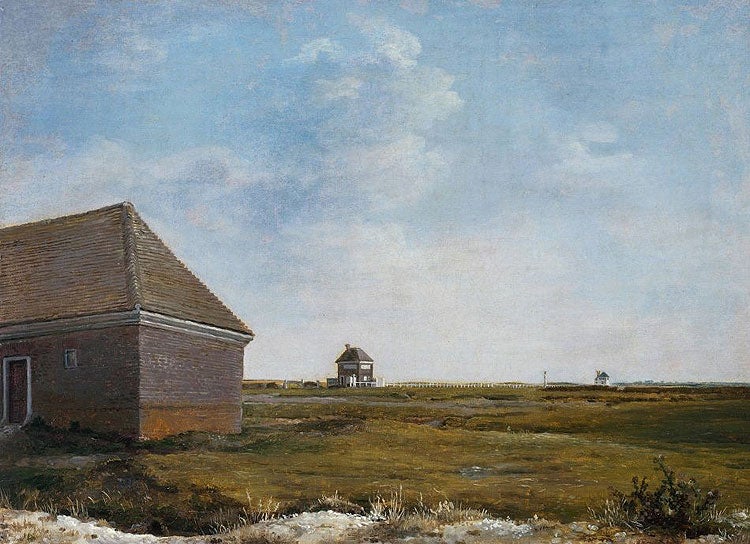George Stubbs: Newmarket Heath, with a Rubbing-Down House (c1765)

"Pictures of nothing, and very like", was how the critic William Hazlitt characterised the work of Turner. He meant that Turner's painting was a meaningless blur, a field of lost focus, where "all is without form and void".
There's another way, though, in which you can paint a picture of nothing. Your picture is not a blank. It depicts a scene that's perfectly definite and recognisable. But it doesn't offer anything that counts as a proper subject. It lacks a protagonist, a focal point, a centre of attention.
George Stubbs' Newmarket Heath, with a Rubbing-Down House is a picture like that. There's no mystery about what it shows. It's a view of the famous racecourse, with a stretch of ground, an expanse of sky, three small buildings and some railings. But if you ask what exactly this is a picture of, you find you're embarked on a process of elimination.
It has no people, no animals, no subject matter of that sort. So, perhaps it's a picture of a building, of the square brick structure with a tiled roof sitting prominently front left. There are pictures of churches and country houses, why not of a rubbing-down house? It's a striking enough form, with the slant of its roof pitched at exactly 45 degrees.
The only problem is that this building isn't quite in subject position. It doesn't hold the picture's stage. It's more like a "wing", in the theatrical sense, a piece of scenery at the side of the stage, which, in both theatrical and traditional art terminology, is called a "coulisse". It's a framing device, something that pokes in and brackets the main scene.
And what is the main scene? Is it a landscape? Possibly. There's a foreground: an undulating chalky bank passes across the bottom of the picture, with a rather sudden ditch just beyond it, half-concealed, like a ha-ha. And there's a background, in the bright but vaguely cloudy sky. But between them?
Very flat, Cambridgeshire. Some landscapes focus on a dominant feature – a wood, hill, waterfall. Others focus on a pathway, a journey laid down for the eye to follow, from one feature to another, and through the gaps between them, away into the distance.
But the land here is too uneventful to qualify on either score. The horizon is level. The remoter buildings are items of background scenery. The flat ground is utterly vacant. The whole scene, with its framing device, its foreground, its background – and nothing else – is an empty stage.
Of course, that's just what it is. It's a racecourse, in the early morning. It's a stage, waiting for the actors to arrive and the action to begin. We're looking at a place of anticipation. The lack of a subject, the missing centre, is precisely the point. The scene is set in expectation of the coming day.
Newmarket Heath, with a Rubbing-Down House is arranged so as to convey a conspicuous absence. And the proof is, you can compare it with other Stubbs paintings, which have an almost identical scene, except that some subject matter – horses, riders – have been added on to it.
Yet that isn't quite the whole story. This picture is not simply a kind of anti-picture, a setting without a subject. As it stands, the picture is full enough. It may look like a dramatically empty stage, but its trick is to keep our attention moving between one almost-focus and another.
The rubbing-down house, after all, is a bit more than a framing "wing". It pokes in quite a way. It almost commands the view. And the sequence of three houses, diminishing into the distance, compose an economical version of the kind of eye-leading pathway that you find in more regular landscape paintings.
And as for the missing centre: well, if you're looking for a protagonist, isn't it actually staring you in the face? The heath itself, the turf, the grass arena on which the great races are lost and won, is what this painting portrays.
It lies bathed in a soft morning light, like holy ground, like a famous battlefield. A picture of nothing? Stubbs' painting is one of the greatest compliments ever paid to a place.
The artist
George Stubbs (1724-1806) is the best English painter. Not Gainsborough, not Reynolds, not Constable, not Turner: Stubbs the horse-painter wins by several lengths. He began his career in the North, travelled to Italy, spent two years studying equine anatomy, and went on to raise the semi-naïf, vernacular practice of animal painting to extraordinary heights. He makes the horse a universal metaphor: highly bred, trained and socialised; or romantically wild; or part of a utopian society. He treats all his fellow creatures, animal and human, equally. He is a master of design – of shape, rhythm, interval, repetition – a great colourist, a great comedian. He hasn't yet received his due.
Subscribe to Independent Premium to bookmark this article
Want to bookmark your favourite articles and stories to read or reference later? Start your Independent Premium subscription today.

Join our commenting forum
Join thought-provoking conversations, follow other Independent readers and see their replies